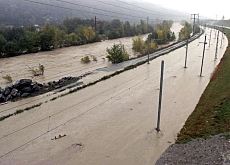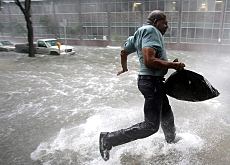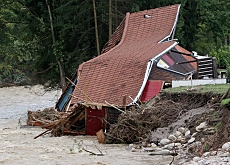More funding needed to reduce disaster risk

Huge costs are a key reason why Switzerland is years away from implementing the most effective systems to limit damage from natural disasters.
Swiss experts told an international conference in Davos that their government’s policy had undergone a “paradigm change from disaster prevention towards a culture of risk reduction”.
Switzerland has suffered several severe floods over the past 15 years. Last year’s natural disaster alone cost the country an estimated SFr2.5 billion ($2.04 billion).
The southern canton of Valais was singled out in 1993 and 2000 when the River Rhone flooded, causing extensive damage.
The cantonal authorities have undertaken a project to widen the river, which Dominique Bérod, a Valais official, said was the best flood prevention.
But he told a session of the International Disaster Reduction Conference that the “correction” of the Rhone carried a price tag of SFr1.24 billion, and would take 30 years to complete.
In the meantime, Bérod said his government was focusing on improving rescue services and implementing so-called mobile protection systems, such as bridges which could be raised in a matter of hours.
His canton has hatched a plan to exploit the unused capacity of the many hydroelectric dams in the mountainous region to hold back excess water flows after heavy rains.
Dam retention
“In the autumn flooding season, there is around five or ten per cent of the dams’ retention volume still available,” Bérod told swissinfo. “Ten per cent equals about 200 million cubic metres of water, which is enough to cause the Rhone to flood.”
Canton Valais is working together with Switzerland’s federal institutes of technology and national weather service to develop a flood-forecasting model. Bérod says the first tests will take place next year, and the system could be up and running by 2008.
However, he admits the canton and electricity companies are still far apart on agreeing how much compensation to pay the suppliers for loss of income due to a decrease in power generation.
Funding
Funding is also the reason it is taking much longer than planned to complete hazard maps for the entire country, according to Laurent Vulliet of Lausanne’s Federal Institute of Technology.
“They were expected to be completed five years ago, but only half of Switzerland has been mapped so far,” Vulliet told swissinfo.
The scientist, who is also a member of Planat – the National Platform for Natural Hazards – added that the frequency of natural disasters was pushing risk reduction up the political agenda. “It’s cynical to say that, but the more events we have the easier it is to pass more laws to get the funding for more research and measures.”
.
The Swiss government set up Planat in 1997 to work “towards a long-term shift in handling natural hazards…promoting a shift from solely averting danger to a risk culture, and makes sure that measures taken are ecologically compatible, socially just and economically effective and efficient.”
Vulliet said the scientific community needed to focus more on the practical side of risk reduction. He said research in recent years had focused on assessing threats while there had been little investigation into reduction measures or disaster management.
He also said there needed to be greater public awareness of the variety and severity of risks to bring pressure on the government to implement effective policies.
“If you ask the average Swiss about the main risk, he will answer avalanches. But economically, avalanches are no longer much of a problem, and don’t cause many deaths,” Vulliet said.
“Earthquakes represent the highest risks, as evaluated by the Swiss government. But the population’s awareness of that is close to zero. That’s the reality.”
swissinfo, Dale Bechtel in Davos
The conference (August 27-September 1) is jointly organised by the United Nations International Strategy for Disaster Reduction, the UN Educational, Scientific and Cultural Organization, the Global Alliance for Disaster Reduction and the Global Disaster Information Network.
The main sponsor is the Swiss Agency for Development and Cooperation.
Planat (National Platform for Natural Hazards) is an advisory board to the Swiss government.
It is an interdisciplinary team of experts composed of representatives from the research community, private sector including insurance companies, government agencies and cantonal authorities.
Planat promotes comprehensive protection which include prevention, intervention and recovery while taking into account numerous technical, ecological, economic and social risks.

In compliance with the JTI standards
More: SWI swissinfo.ch certified by the Journalism Trust Initiative



You can find an overview of ongoing debates with our journalists here. Please join us!
If you want to start a conversation about a topic raised in this article or want to report factual errors, email us at english@swissinfo.ch.